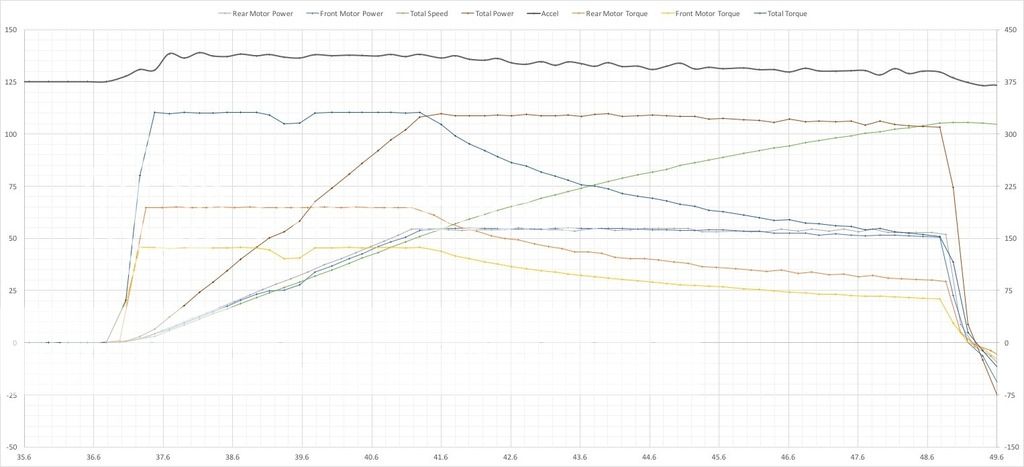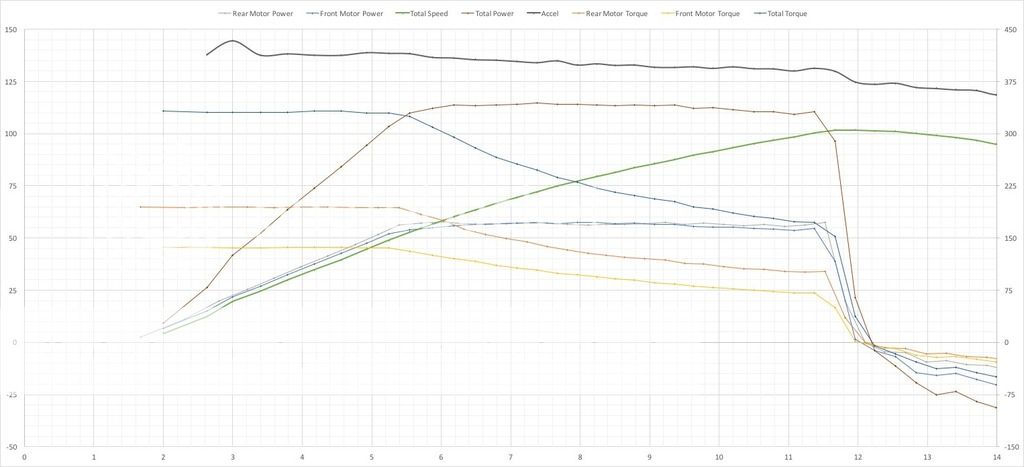anko
Well-known member
We were still looking for a comparison between an old PHEV and a MY16. Thanks to Stefan from Sweden, I can now present some pictures.
The first graph shows me taking off in my MY14. The second shows Stefan taking off in his MY16.


Both graphs has the exact same timescale and scales for Y values.
In addition to earlier graphs I presented here, I added a black trace that shows acceleration in terms of (km/h)/sec. In order to separate it from the other traces, I added 125 to every value. So, for example I constant value of 135 here would result in 0 - 100 km/h time 10 seconds.
Unfortunately, when Stefan started his run, the monitoring tool hadn't fully settled yet, causing the first half of a second of data to be missing. I believe this "settling" also may have caused the little spike at the beginning of the black acceleration trace. That spike matches a little dent in the green trace, which represents speed. When I manually change the timestamp for the third speed reading from 2,62 seconds to 2.52 seconds (so, shift it back just 10/100s of a second), the dent in the green line goes away. And so does there spike in the black line. See third graph:

Anyway, the purpose of the exercise was to compare older PHEVs to MY16 PHEVs. To be honest, I do not see much of a significant difference. If anything, two things stand out:
- The combined power above 55 km/h is a little bit higher (MY16 peeks at 114.75, MY14 peeks at 109.70), visually resulting in a 0.4 second faster 0-100 time (as far as we can tell exactly, with the first half second missing). It could be a MY difference. But it could also be caused by the fact that when I did the run, my car had already switched to hybride mode because of low SOC. Possibly battery output was slightly reduced, because of this.
- Although both the MY14 and the MY16 run were in Normal mode (so not using the Charge button to pre start the engine), we see a small dip in Torque and power build up between 25 and 30 km/h (which I have contributed to the generator not being fully awake yet) for the MY14, which we do not see for the MY16. But the result of this is not apparent.
All together, difficult to tell. Are there really differences? And if so, are they perhaps caused by the crude monitoring tools, by differences in drivers, .... Who will tell. All I can say for now is that based on these graphs I do not see any evidence af a 2 second improvement early in the sprint.
The first graph shows me taking off in my MY14. The second shows Stefan taking off in his MY16.


Both graphs has the exact same timescale and scales for Y values.
In addition to earlier graphs I presented here, I added a black trace that shows acceleration in terms of (km/h)/sec. In order to separate it from the other traces, I added 125 to every value. So, for example I constant value of 135 here would result in 0 - 100 km/h time 10 seconds.
Unfortunately, when Stefan started his run, the monitoring tool hadn't fully settled yet, causing the first half of a second of data to be missing. I believe this "settling" also may have caused the little spike at the beginning of the black acceleration trace. That spike matches a little dent in the green trace, which represents speed. When I manually change the timestamp for the third speed reading from 2,62 seconds to 2.52 seconds (so, shift it back just 10/100s of a second), the dent in the green line goes away. And so does there spike in the black line. See third graph:

Anyway, the purpose of the exercise was to compare older PHEVs to MY16 PHEVs. To be honest, I do not see much of a significant difference. If anything, two things stand out:
- The combined power above 55 km/h is a little bit higher (MY16 peeks at 114.75, MY14 peeks at 109.70), visually resulting in a 0.4 second faster 0-100 time (as far as we can tell exactly, with the first half second missing). It could be a MY difference. But it could also be caused by the fact that when I did the run, my car had already switched to hybride mode because of low SOC. Possibly battery output was slightly reduced, because of this.
- Although both the MY14 and the MY16 run were in Normal mode (so not using the Charge button to pre start the engine), we see a small dip in Torque and power build up between 25 and 30 km/h (which I have contributed to the generator not being fully awake yet) for the MY14, which we do not see for the MY16. But the result of this is not apparent.
All together, difficult to tell. Are there really differences? And if so, are they perhaps caused by the crude monitoring tools, by differences in drivers, .... Who will tell. All I can say for now is that based on these graphs I do not see any evidence af a 2 second improvement early in the sprint.

















